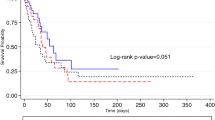Abstract
Healthcare-associated pneumonia (HCAP) is a new category that is essential in the present aging society. Knowing the different characteristics and outcomes between patients with HCAP and community-acquired pneumonia (CAP) would help physicians manage and treat HCAP patients. Although HCAP is thought to be heterogeneous in regions, there are no reports from a metropolitan area in Japan. We retrospectively reviewed the clinical findings of all consecutive pneumonia patients who required hospitalized care in our hospital between April 2006 and March 2010. There were 184 (35.0%) patients with HCAP and 342 (65.0%) patients with CAP. Previous hospitalization within 90 days of the infection was the most common criterion for HCAP (63.0%). HCAP patients were significantly older than CAP patients (82.5 vs. 70.0 years, P < 0.001). The percentage of patients with poor functional status was higher in HCAP than CAP (64.0% vs. 26.6%, P < 0.001). Hospital mortality was significantly higher in HCAP patients than in CAP patients (15.8% vs. 5.0%, P < 0.001). Low levels of serum albumin (odds ratio, 0.126; 95% CI, 0.025–0.640; P = 0.012) and high scores in the ADROP (age, dehydration, respiratory failure, orientation, and blood pressure) system (odds ratio, 2.846; 95% CI, 1.449–5.587; P = 0.002) were the risk factors for HCAP mortality. In conclusion, patients with HCAP have different epidemiological characteristics compared with those with CAP in a metropolitan area of Japan. Outcomes and risk factors for mortality of patients with HCAP included poor nutritional status and high severity scores on the pneumonia severity scoring system.
Similar content being viewed by others
References
Mandell LA, Wunderink RG, Anzueto A, Bartlett JG, Campbell D, Dean NC, et al. Infectious Disease Society of America/American Thoracic Society consensus guidelines on the management of community-acquired pneumonia in adults. Clin Infect Dis. 2007;44:S27–72.
American Thoracic Society; Infectious Diseases Society of America. Guidelines for the management of adults with hospital-acquired, ventilator-associated, and healthcare-associated pneumonia. Am J Respir Crit Care Med. 2005;171:388–416.
Kollef MH, Shorr A, Tabak YP, Gupta V, Liu LZ, Johannes RS. Epidemiology and outcomes of health-care-associated pneumonia: results from a large US database of culture-positive pneumonia. Chest. 2005;128:3854–62.
Brito V, Niederman MS. Health-care-associated pneumonia is a heterogeneous disease, and all patients do not need the same broad-spectrum antibiotic therapy as complex nosocomial pneumonia. Curr Opin Infect Dis. 2009;22:316–25.
Micek ST, Kollef KE, Reichley RM, Roubinian N, Kollef MH. Health care-associated pneumonia and community-acquired pneumonia: a single-center experience. Antimicrob Agents Chemother. 2007;51:3568–73.
Lim WS, Baudouin SV, George RC, Hill AT, Jamieson C, Le Jeune I, et al. Pneumonia Guidelines Committee of the BTS Standards of Care Committee. British Thoracic Society guidelines for the management of community acquired pneumonia in adults: update 2009. Thorax. 2009;64(suppl III):iii1–55.
Lim WS, Macfarlane JT. A prospective comparison of nursing home acquired pneumonia with community acquired pneumonia. Eur Respir J. 2001;18:362–8.
Carratala J, Fernandez-Sabe N, Ortega L, Castellsague X, Roson B, Dorca J, et al. Outpatient care compared with hospitalization for community-acquired pneumonia: a randomized trial in low risk patients. Ann Intern Med. 2005;142:165–72.
The Committee for the Japanese Respiratory Society Guidelines in the Management of Respiratory Infections. The Japanese Respiratory Society guidelines for the management of community-acquired pneumonia in adults. Respirology 2006;11:S1–S133.
The Committee for the Japanese Respiratory Society Guidelines in the Management of Respiratory Infections. The Japanese Respiratory Society guidelines for the management of hospital-acquired pneumonia in adults. Respirology 2009;14:S1–S71.
Shindo Y, Sato S, Maruyama E, Ohashi T, Ogawa M, Hashimoto N, et al. Health-care-associated pneumonia among hospitalized patients in a Japanese community hospital. Chest. 2009;135:633–40.
Seki M, Hashiguchi K, Tanaka A, Kosai K, Kakugawa T, Awaya Y, et al. Characteristics and disease severity of healthcare-associated pneumonia among patients in a hospital in Kitakyushu, Japan. J Infect Chemother 2010. doi:10.1007/s10156-010-0127-8.
Maruyama T, Niederman MA, Kobayashi T, Kobayashi H, Takagi T, D’Alessandro-Gabazza CN, et al. A prospective comparison of nursing home-acquired pneumonia with hospital-acquired pneumonia in non-intubated elderly. Respir Med. 2008;102:1287–95.
Yamagishi Y, Mikamo H. A retrospective study of health care-associated pneumonia patients at Aichi Medical University hospital. J Infect Chemother 2011. doi:10.1007/s10156-011-0252-z.
Carratala J, Mykietiuk A, Fernandez-Sabe N, Suarez C, Dorca J, Verdaguer R, et al. Health care-associated pneumonia requiring hospital admission. Arch Intern Med. 2007;167:1393–9.
Venditti M, Falcone M, Corrao S, Licata G, Serra P, and the Study Group of Italian Society of Internal Medicine. Outcomes of patients hospitalized with community-acquired, health care-associated, and hospital-acquired pneumonia. Ann Intern Med 2009;150:19–26.
Park HK, Song JU, Um SW, Koh WJ, Suh GY, Chung MP, et al. Clinical characteristics of health care-associated pneumonia in a Korean teaching hospital. Respir Med. 2010;104:1729–35.
United Nations Population Division, World Population Prospects: The 2008 Revision Populations Database, 11 March 2009 Updated. http://esa.un.org/unpp/index.asp?panel=2. Accessed 6 February 2011.
Statistics Division Bureau of General Affairs, 31 January 2011 Updated. Statistics of Tokyo. http://www.toukei.metro.tokyo.jp/index.htm. Accessed 6 February 2011.
Ministry of Internal Affairs and Communications, Statistics Bureau, Director-General for Policy Planning(Statistical Standards)and Statistical Research and Training Institute, 10 September 2009 Updated. http://www.stat.go.jp/data/topics/topi411.htm. Accessed 6 February 2011.
Rello J, Luján M, Gallego M, Valles J, Belmonte Y, Fontanals D, et al. Why mortality is increased in health-care-associated pneumonia. Lessons from pneumococcal bacteremic pneumonia. Chest. 2010;137:1138–44.
Ewig S, Welte T, Chastre J, Torres A. Rethinking the concepts of community-acquired and health-care-associated pneumonia. Lancet Infect Dis. 2010;10:279–87.
Corti MC, Guralnik JM, Salive ME, Sorkin JD. Serum albumin level and physical disability as predictors of mortality in older persons. JAMA. 1994;272:1036–42.
Walter LC, Brand RJ, Counsell SR, Palmer RM, Landefeld CS, Fortinsky RH. Development and validation of a prognostic index for 1-year mortality in older adults after hospitalization. JAMA. 2001;285:2987–94.
Author information
Authors and Affiliations
Corresponding author
About this article
Cite this article
Sugisaki, M., Enomoto, T., Shibuya, Y. et al. Clinical characteristics of healthcare-associated pneumonia in a public hospital in a metropolitan area of Japan. J Infect Chemother 18, 352–360 (2012). https://doi.org/10.1007/s10156-011-0344-9
Received:
Accepted:
Published:
Issue Date:
DOI: https://doi.org/10.1007/s10156-011-0344-9




